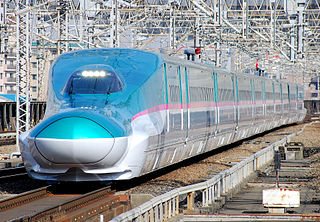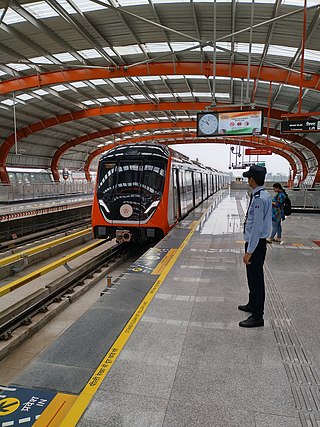Related Research Articles
Rail transport is an important mode of conveyance for people and goods in India. Indian Railways (IR) is the primary operator of rail operations throughout the country. IR is a state-owned organisation of the Ministry of Railways, which historically had its own government budget. Between 2019 and 2020, 22.15 million passengers used the Indian Railways network daily. In the same period, 3.32 million metric tons of freight was also shipped daily on the IR network.

The Mumbai Suburban Railway consists of exclusive inner suburban railway lines augmented by commuter rail on main lines serving outlying suburbs to serve the Mumbai Metropolitan Region. Spread over 390 kilometres (240 mi), the suburban railway operates 2,342 train services and carries more than 7.5 million commuters daily.

Indian Railways (IR) is a statutory body under the ownership of the Ministry of Railways, Government of India that operates India's national railway system. It manages the fourth largest national railway system in the world by size, with a total route length of 68,043 km (42,280 mi), running track length of 102,831 km (63,896 mi) and track length of 128,305 km (79,725 mi) as of 31 March 2022. 58,812 km (36,544 mi) of all the gauge routes are electrified with 25 kV 50 Hz AC electric traction as of 1 April 2023.

The Mumbai Metro is a rapid transit (MRT) system serving the city of Mumbai and the wider Mumbai Metropolitan Region in Maharashtra, India.

Pakistan Railways is the national, state-owned railway company of Pakistan in Lahore. Founded in 1861 as the North Western State Railway and headquartered in Lahore, it owns 7,490 kilometres of operational track across Pakistan, stretching from Torkham to Karachi, offering both freight and passenger services.

The British Rail Mark 3 is a type of passenger carriage developed in response to growing competition from airlines and the car in the 1970s. A variant of the Mark 3 became the rolling stock for the High Speed Train (HST).
The Harbour line is a branch line of the Mumbai Suburban Railway operated by Central Railway. It was named so because it catered to the eastern neighbourhoods along the city's natural harbour. Its termini are Chhatrapati Shivaji Maharaj Terminus (CSMT), Goregaon and Panvel on the CSMT-Goregaon, CSMT-Panvel and Panvel-Goregaon routes.

Namma Metro, also known as Bengaluru Metro, is a rapid transit system serving the city of Bengaluru, India. It is the second longest operational metro network in India after Delhi Metro. Upon its inauguration, it became the first underground metro system in South India. Namma Metro has a mix of underground, at grade, and elevated stations. Out of the operational 64 metro stations of Namma Metro as of March 2023, there are 55 elevated stations, 8 underground stations and 1 at-grade station. The system runs on standard-gauge tracks.

Indian Railways does not currently have any operational high-speed rail lines, though a total of eight corridors have been approved, with the corridor between Mumbai and Ahmedabad under construction. As of 2023, the fastest train services in India are the Gatimaan Express and Rani Kamalapati (Habibganj)–Hazrat Nizamuddin Vande Bharat Express with peak operational speed of 160 km/h (99 mph) on the Tughlakabad – Agra Cantonment section of the route.
The Western Railway Elevated Corridor, also known as the Oval Maidan-Virar elevated corridor, was a proposed rapid transit corridor that would have run along the same alignment as the Western Line of the Mumbai Suburban Railway, and link Oval Maidan with Virar.

The Kanpur Metro is a mass rapid transit (MRT) system in Kanpur, Uttar Pradesh, India. The metro is owned and operated by the Uttar Pradesh Metro Rail Corporation (UPMRC).

Urban rail transit in India plays an important role in intracity transportation in the major cities which are highly populated. It consists of rapid transit, suburban rail, monorail and tram systems. According to a report published in 2021, a total of 2.63 billion people travelled annually in metro systems across India's fifteen major cities, placing the country as one of the busiest urban rapid transit hubs in the world in terms of ridership. The combined length of 859 kilometres of metro systems in India makes it the fourth longest in operation in the world.

The Purple Line is a part of the Namma Metro rail system for the city of Bengaluru, Karnataka, India. As of 2023, the line is 39.4 km (24.5 mi) and spans 35 stations from Kengeri in the southwest to Baiyappanahalli to the east. India's prime minister, Narendra Modi, inaugurated the metro line from Krishnarajapura to Whitefield (Kadugodi) on March 25. The Purple Line is mostly elevated, with 29 elevated stations, 5 underground stations and 1 at-grade station. The Line passes through many prime activity centers of the city including Whitefield, Krishnarajapura, MG Road, Vidhana Soudha and Majestic station, which is an interchange station between Purple and Green Lines. Phase I of the Purple Line was the first underground metro section in South India.

The Delhi Metro is a mass rapid transit (MRT) system serving Delhi and its satellite cities of Ghaziabad, Faridabad, Gurugram, Noida and Bahadurgarh, in the National Capital Region of India. The network consists of 12 colour-coded lines serving 287 stations with a total length of 391 kilometres (243 mi). It is the largest and busiest metro rail system in India, and the second oldest after the Kolkata Metro. The system has a mix of underground, at-grade, and elevated stations using both broad-gauge and standard-gauge. Delhi Metro operates over 2,700 trips daily, starting at around 05:30 and ending at 23:30.

Mumbai–Ahmedabad High Speed Rail Corridor (MAHSR), or Mumbai–Ahmedabad HSR, is an under-construction high-speed rail line, which will connect India's economic and financial hub and Maharashtra’s capital, Mumbai, with the largest city of the state of Gujarat, Ahmedabad. When completed, it will be India's first high-speed rail line.

Patna Metro (Patna MRTS) is a rapid transit system under construction (as of May 2023), in the city of Patna, India. Construction will be completed over five phases, and will be owned and operated by the state-run Patna Metro Rail Corporation. In the first phase, five stations of Patna Metro will be operational by March 2025. Patna MRTS, constructed under a Public Private Partnership mode, is estimated to cost ₹133,657.7 million (US$1.7 billion). This cost excludes land acquisition cost, which will be paid for by the Bihar government. The first phase (consisting of the east–west and north–south corridors) will include both a 23.30 km (14.48 mi) elevated track and a 16.30 km (10.13 mi) underground track.

Panvel railway station is a railway station on the Harbour Line and Central line of the Mumbai Suburban Railway network.

Higher-speed rail (HrSR), also known as high-performance rail, higher-performance rail, semi-high-speed rail or almost-high-speed rail, is the jargon used to describe inter-city passenger rail services that have top speeds of more than conventional rail but are not high enough to be called high-speed rail services. The term is also used by planners to identify the incremental rail improvements to increase train speeds and reduce travel time as alternatives to larger efforts to create or expand the high-speed rail networks.
The Indian Government is undertaking several initiatives to upgrade its aging railway infrastructure and enhance its quality of service. The Railway Ministry has announced plans to invest ₹5,400,000 crore to upgrade the railways by 2030. Upgrades include 100% electrification of railways, upgrading existing lines with more facilities and higher speeds, expansion of new lines, upgrading railway stations, introducing and eventually developing a large high-speed train network interconnecting major cities in different parts of India and development of various dedicated freight corridors to cut down cargo costs within the country.
The Delhi–Meerut Regional Rapid Transit System is an 82.15 km (51.05 mi) long, semi-high speed rail corridor currently under construction which will connect Delhi, Ghaziabad, and Meerut. It is one of the three rapid rail corridors planned under Phase I of the RapidX project managed by the National Capital Region Transport Corporation (NCRTC). With a maximum speed of 180 km/h (111.85 mph), the distance between Delhi and Meerut will be covered in less than 60 minutes. The project will cost ₹30,274 crore (US$3.8 billion) and will have 22 stations, and two Depots at Duhai and Modipuram.
References
- ↑ "India's First Green Rail Corridor Launched In Tamil Nadu". NDTV.com. Retrieved 2021-12-31.
- ↑ "India's first 'Green corridor' inaugurated". The Hindu. 2016-07-25. ISSN 0971-751X . Retrieved 2021-12-31.